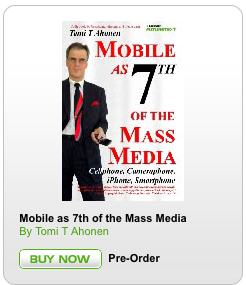Tomi's new book: Mobile as the 7th Mass Media
Tomi Ahonen‘s got a new book coming — the title is ‘Mobile as the 7th Mass Media’ and it’s shaping up to be a rather interesting read. I always enjoy Tomi’s blog posts so I’ve just pre-ordered a copy of his book.
He’s kindly sent over a free chapter for my perusal and I’ve copied the first few paragraphs from it to give you an idea as to the quality of his writing. The book is £20 + postage and you can order now.
I just took a screenshot of the book from the Futuretext site — I’ve linked it to the ordering page:
Here’s the first few paragraphs:
– – – – –
Because the need to communicate is more powerful than the need to compute, to be entertained, or to be informed.
At the end of 2007 there were almost three times as many cellphone subscriptions as there were total users on the internet. There were four times as many cellphones as there are personal computers of all kinds laptops, desktops and servers combined. There were more than five times as many cellphone subscriptions in the world as there were cars. Twice as many people had cellphones as had credit cards. The population of cellphones was twice as big as the population of TV sets in use.
There were 2.5 times as many cellphones as there were fixed landline phones.
In fact, by late November 2007 there was a cellphone subscription for a staggering 50% of the world’s total population. Since Taiwan first did it in 2001, today over 60 countries have achieved cellphone penetration rates of over 100% per capita. For comparison, the USA cellphone penetration rate was about 85% at the end of 2007, placing it second-to-last among industrialized countries. Canada was in last place with about 65% penetration. In the most advanced mobile markets such as Hong Kong, Taiwan, Italy and Finland, the typical first-time cellphone customer is well under the age of eight.
How can you reach over 100% per capita penetration rates? Hong Kong, Taiwan, Italy, Israel, the UK are all at 130% or above – means that an increasing part of the employed population has two or more subscriptions. Informa measured that by 2007 already 28% of all cellphone owners in the world already have two or more subscriptions. Moreover, in most cases this means also carrying two phones. Half of Western Europeans with a cellphone actually have two or more subscriptions – and most of them carry two phones.
There is no other gadget that is even remotely as widely adopted and spread across the planet as the cellphone. Anyone with a job and disposable income has a cellphone, so if you want to sell anything, anyone who is “economically viable” on the planet, carries a cellphone. Even in China (40% penetration rate per capita), India (20%) and Africa (15%) cellphones are everywhere. I will discuss the overall economics, the big picture numbers and contrasts to other major technologies in the next chapter about the numbers involved in this industry soon to hit a Trillion dollars in value.
Then I will examine the owners of cellphones and how they use the devices. I will explore the society and how our behavior is changing with this technology. Earlier, the only gadget the “whole population” used to carry was the wristwatch. However, even here the cellphone is trumping the watch: young people have stopped using wristwatches and rely only upon the cellphone to tell time. A global Nokia survey of cellphone users in 2006 found that 73% of cellphone owners use the clock on the phone. Not all of these have abandoned wearing a wristwatch, but an increasing portion of the world uses the phone as the only time-keeping device.
The cellphone is the only universal device.
– – – – –
Fascinating reading. Every success, Tomi!




